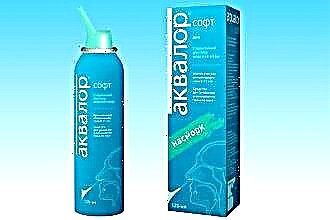 Violation of the drainage function of the nose leads to discomfort in the area of the eyebrows and the bridge of the nose, at the level of which the paranasal sinuses are located. There can be a lot of reasons for nasal congestion, therefore, the type of pathology can be determined by concomitant clinical manifestations and the results of a rhinoscopic examination. The absence of elevated temperature (subfebrile) fever most often indicates a chronic or allergic inflammation of the upper ENT organs. From the publication you will learn about the causes of deterioration in health and methods of treatment of diseases that are accompanied by headaches and nasal breathing problems.
Violation of the drainage function of the nose leads to discomfort in the area of the eyebrows and the bridge of the nose, at the level of which the paranasal sinuses are located. There can be a lot of reasons for nasal congestion, therefore, the type of pathology can be determined by concomitant clinical manifestations and the results of a rhinoscopic examination. The absence of elevated temperature (subfebrile) fever most often indicates a chronic or allergic inflammation of the upper ENT organs. From the publication you will learn about the causes of deterioration in health and methods of treatment of diseases that are accompanied by headaches and nasal breathing problems.
Causes
Nasal congestion and headache is a pathological symptom that indicates the presence of edema in the paranasal sinuses and nasal cavity. Infectious inflammation is not always the cause of impaired drainage function of the nose. In about 4 out of 10 cases, difficulty in nasal breathing is associated with allergic reactions and neoplasms in the nose. If you do not start the treatment of pathologies in time, this will lead to the destruction of not only soft, but also cartilaginous tissues. In this case, it will be possible to eliminate the consequences of the disease only with the help of physiotherapy and surgical intervention.
Sinusitis
Bursting pain at the level of the forehead and nasal congestion are companions of chronic inflammation in the paranasal sinuses. The disease often develops as a complication of acute sinusitis, rhinorrhea, flu, tonsillitis, etc. Pathogenic microbes, especially Staphylococcus aureus and Streptococcus, act as provocateurs of sluggish inflammation.
Depending on the localization of the lesions, the following types of sinusitis are diagnosed:
- sinusitis - damage to the maxillary sinuses, located at the level of the cheeks;
- ethmoiditis - defeat of the ethmoid labyrinth in the thickness of the ethmoid bone, which is at the level of the cartilaginous part of the nasal septum;
- sphenoiditis - damage to the sphenoid sinus, located near the ethmoid labyrinth;
- frontal sinusitis is a lesion of the frontal sinuses at the level of the eyebrows.
If the patient's eyes and forehead hurt, as a rule, this indicates the development of frontal sinusitis.
With sinusitis, the mucous membranes of the paranasal sinuses are inflamed, in which there are a small number of glands that produce muconasal secretions. Due to edema of the anastomosis of the nasal sinuses, mucus is not evacuated from the respiratory tract, but accumulates inside the nasopharynx. As a result, this leads to the fact that the patient's forehead begins to ache and the nose becomes blocked.
Neoplasms in the nose
Violation of nasal breathing, headache and decreased sense of smell can be a consequence of the growth of benign tumors in the nasal cavity. Neoplasms occur due to chronic inflammation of the tissues of the nasopharynx, malfunctioning of the thyroid gland, allergic reactions, etc. If the patient has a very stuffy nose, but there is no mucous discharge, this may indicate a blockage of the nasal canals by the following tumors:
- myxoma;
- angioma;
- chordoma;
- fibroma;
- papilloma;
- dermoid cyst.
Work in hazardous industries and frequent injuries to the nasopharynx are the main trigger factors for the occurrence of tumors.
In cases where a stuffy nose and a headache, but there is no temperature, you need to undergo a rhinoscopic examination by a specialist. If a tumor is detected, the doctor will take biomaterials for histological analysis, according to the results of which he will be able to establish the tissue origin of the neoplasms.
Allergic rhinoconjunctivitis
Lachrymation, nasal breathing and a temperature of 37 ° C most often indicate an allergic inflammation of the nasopharynx. The provocateur of pathological reactions in the respiratory organs is often the pollen of wind-pollinated plants. Therefore, rhinoconjunctivitis is most often exacerbated during the flowering periods of such trees and plants:
- oak;
- poplar;
 rye;
rye;- wheat;
- ambrosia;
- feather grass;
- Birch.
With allergies in the mucous membranes, angioedema occurs, due to which the patency of the nasal passages is impaired. Due to the accumulation of mucus in the nasal cavity, patients have a headache, difficulty breathing and watery eyes. Treatment of allergic diseases should be accompanied by the intake of antihistamines.
If the manifestations of the disease are not stopped in time, this can lead to severe swelling not only of the nasal cavity, but also of the throat, which is fraught with acute hypoxia (oxygen starvation).
Respiratory Disease Treatment
If a stuffy nose and a headache, but there is no temperature, how to treat the disease? Systemic and local antibiotics form the basis of treatment for infectious lesions of the ENT organs. To improve the drainage of the paranasal sinuses, patients are prescribed vasoconstrictor and anti-inflammatory drugs. In the chronic course of inflammatory processes, treatment is carried out using hardware procedures aimed at restoring the integrity of tissues and increasing local immunity.
Drug therapy
What to do if nasal congestion is due to the development of a respiratory illness? The absence of temperature indicates the presence of chronic foci of inflammation in the accessory sinuses. As a rule, the following types of drugs are included in the treatment regimen for bacterial sinusitis:
| Medication type | pharmachologic effect | Name of the medicine |
|---|---|---|
| systemic antibiotics | destroy the cell membranes of bacteria, which leads to their death |
|
| local antibiotics | prevent the growth of microbes in the nasal cavity |
|
| vasoconstrictor drops | reduce swelling and restore airway patency |
|
| antiseptics | disinfect the nasopharynx and prevent the development of microbial flora |
|
| mucolytics | reduce the viscosity of mucus, which promotes its excretion from the accessory sinuses |
|
| moisturizing drops | prevent drying out of the nasopharyngeal mucosa |
|
| non-steroidal anti-inflammatory drugs | relieve pain and accelerate the regression of bacterial inflammation |
|
Antibiotic treatment is carried out in courses of 7-10 days, during which the patient must take medications in the dosages indicated by the doctor.
Physiotherapy
If, after carrying out drug therapy, the nose still clogs up, the patient is prescribed physiotherapy. Physiotherapy helps to restore the integrity of the mucous membranes and thereby increase the body's resistance to bacterial infection. In cases where the forehead hurts and periodically clogs up the nose, the doctor prescribes the following types of hardware procedures:
- electrophoresis - the introduction of anti-inflammatory drugs into the tissues of the nasal cavity using constant currents;
- ultrasound - micromassage effect of ultrasonic waves on the nasopharyngeal mucosa, which promotes tissue regeneration;
- UHF therapy - the impact on the foci of inflammation by high-frequency electromagnetic fields, which have a pronounced anti-inflammatory and wound-healing effect.
If the head aches due to the accumulation of pus in the paranasal sinuses, the patient is prescribed a minimally invasive operation (puncture). During surgery, a needle is inserted into the affected sinuses, with the help of which purulent masses are removed from the inflamed cavities.
Treatment of tumors in the nose
What to do if a tumor forms in the nose? Benign tumors in the respiratory tract can only be diagnosed by an otolaryngologist. To differentiate the neoplasm from foreign objects, the doctor will perform a rhinoscopy. Tumors that are difficult from a diagnostic point of view are examined using endoscopic examination and tissue biopsy.
In most cases, treatment is carried out surgically, since tumors are prone to malignancy. The method of removing neoplasms depends on their location and size. Small neoplasms are excised with a radio wave or laser knife. The operated tissues are immediately subjected to cryo-treatment or electrocoagulation, which prevents bleeding.
Chondromas often affect bone and cartilage tissue, so their removal is carried out in several stages. Sometimes the surgeon needs not only internal (endonasal), but also external surgical approaches to the tumor. In the case of resection of bone structures, obvious cosmetic defects often arise, which are subsequently eliminated with rhinoplasty.
Treatment of allergic manifestations
What to do if allergic rhinoconjunctivitis develops? Pollinosis therapy is aimed at stopping allergic reactions and eliminating causally significant allergens. The most important role in the treatment of allergies is played by drug therapy, with the help of which it is possible to eliminate angioedema of the nasopharynx and concomitant manifestations of the disease. If the nose is blocked due to an exacerbation of allergic rhinoconjunctivitis, the following types of drugs will be used to treat it:
- cromones ("Tiled", "Cromohexal", "Intal") - prevent the release of inflammatory mediators from mast cells, thereby reducing the severity of allergic inflammation;
- topical corticosteroids (Pulmicort, Ingakort, Nazakort) - help to reduce swelling and inflammation in the respiratory tract, have a pronounced vasoconstrictor effect;
- antihistamines ("Lomilan", "Fenistil", Ksizal "") - reduce the sensitivity of histamine receptors, eliminate swelling in the mucous membranes.
It is recommended to use barrier drugs - "Nazaval" and "Ketotifen" as anti-relapse agents.
After carrying out antihistamine therapy, the patient is prescribed anti-relapse medications, with the help of which it is possible to prevent the recurrence of allergies. During the flowering periods of wind-pollinated plants and trees, doctors recommend the use of barrier drugs that prevent the penetration of allergens into the tissues of the respiratory system and reduce the sensitivity of histamine receptors.
Conclusion
Nasal congestion without fever is a symptom indicating a sluggish inflammation in the nasopharynx. Unwanted processes in the nasal passages can be caused by bacterial infections, allergies, or benign tumors. If a violation of nasal breathing is accompanied by headaches, chronic sinusitis is diagnosed in 7 out of 10 cases.
Treatment for respiratory infections is the use of antimicrobial agents and vasoconstrictor drops. Medicines help restore the drainage function of the nose and thereby normalize the outflow of mucus from the paranasal sinuses. Pollinosis is treated with antihistamines, topical glucocorticosteroids and cromones, and tumors are eliminated surgically using endonasal surgery.

 rye;
rye;

